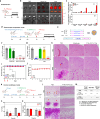Effective treatment of systemic candidiasis by synergistic targeting of cell wall synthesis
- PMID: 40595501
- PMCID: PMC12215473
- DOI: 10.1038/s41467-025-60684-7
Effective treatment of systemic candidiasis by synergistic targeting of cell wall synthesis
Abstract
Fungal infections pose a serious threat to global human health fueled by the increase in immunosuppressive therapies, medical implants, and transplantation. The emergence of multidrug resistance with limited options of current antifungal drugs are a further constraint. There is thus a clear and unmet need to identify therapeutic targets and develop alternative classes of antifungal agents. Here, we hypothesize that dual targeting of key regulatory genes of fungal cell wall synthesis (FKS1 encoding β-1,3-glucan synthase and CHS3 encoding chitin synthase) can synergistically inhibit fungal growth. Based on iterative designs, we generate a small library of fungal-targeted nanoconstructs, and identify a lead construct (FTNx) that shows preferential accumulation in fungal cells over mammalian cells and leads to prominent antifungal effects in vitro. We further show that FTNx is highly effective in a mouse model of disseminated candidiasis, demonstrating diminished fungal growth and enhanced survival rate. This strategy appears promising as an effective treatment for fungal infections in mammalian hosts.
© 2025. The Author(s).
Conflict of interest statement
Competing interests: The authors declare no competing interests.
Figures





Similar articles
-
Anti-Candida albicans natural products, sources of new antifungal drugs: A review.J Mycol Med. 2017 Mar;27(1):1-19. doi: 10.1016/j.mycmed.2016.10.002. Epub 2016 Nov 11. J Mycol Med. 2017. PMID: 27842800
-
Inhibition of candidalysin production by methoxy-apo-enterobactin from Streptomyces ambofaciens CJD34 as a novel antifungal strategy against Candida albicans.J Microbiol. 2025 Jun;63(6):e2504019. doi: 10.71150/jm.2504019. Epub 2025 Jun 30. J Microbiol. 2025. PMID: 40599000
-
Distinct echinocandin responses of Candida albicans and Candida auris cell walls revealed by solid-state NMR.Nat Commun. 2025 Jul 8;16(1):6295. doi: 10.1038/s41467-025-61678-1. Nat Commun. 2025. PMID: 40628778 Free PMC article.
-
Identification of New Antifungal Agents Targeting Chitin Synthesis by a Chemical-Genetic Method.Molecules. 2019 Aug 29;24(17):3155. doi: 10.3390/molecules24173155. Molecules. 2019. PMID: 31470665 Free PMC article.
-
[Pharmacodynamics and pharmacokinetics of micafungin in adults, children and neonate].Rev Iberoam Micol. 2009 Mar 31;26(1):23-34. doi: 10.1016/S1130-1406(09)70005-1. Epub 2009 May 7. Rev Iberoam Micol. 2009. PMID: 19463274 Spanish.
References
MeSH terms
Substances
Supplementary concepts
Grants and funding
LinkOut - more resources
Full Text Sources
Medical

